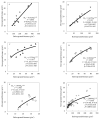Biomass, Carbon and Nitrogen Partitioning and Water Use Efficiency Differences of Five Types of Alpine Grasslands in the Northern Tibetan Plateau
- PMID: 36293622
- PMCID: PMC9602644
- DOI: 10.3390/ijerph192013026
Biomass, Carbon and Nitrogen Partitioning and Water Use Efficiency Differences of Five Types of Alpine Grasslands in the Northern Tibetan Plateau
Abstract
(1) Background: Grassland covers most areas of the northern Tibetan Plateau along with important global terrestrial carbon (C) and nitrogen (N) pools, so there is a need to better understand the different alpine grassland growth associated with ecosystem C, N storage and water use efficiency (WUE). (2) Methods: The plant biomass and C, N concentrations, stocks and vegetation WUE of five kinds of alpine grassland types were investigated in northern Tibetan Plateau. (3) Results: The results showed that there were significant differences among five types of alpine grasslands in aboveground biomass (AGB), belowground biomass (BGB), total biomass (TB) and root:shoot (R/S) ratio while the highest value of different indices was shown in alpine meadow type (AM). The AGB and BGB partitioning results significantly satisfied the allometric biomass partitioning theory. The C, N concentrations and C/N of the vegetation in AGB and BGB showed significant grassland type differences. The highest C, N stocks of BGB were in AM which was almost six or seven times more than the C, N stocks of AGB in alpine desert type (AD). There were significant differences in δ13C and intrinsic water use efficiency (WUEi) under five alpine grassland types while the highest mean values of foliar δ13C and WUEi were in AD. Significant negative correlations were found between WUEi and C, N concentrations, C/N of AGB and soil water content (SWC) while the correlation with BGB C/N was not significant. For AGB, BGB, TB and R/S, there were positive correlations with C, N concentrations of AGB, BGB and SWC while it had significant negative correlations with C/N of BGB. (4) Conclusions: With regard to its types, it is suggested that the AM or AS may be an actively growing grassland type in the northern Tibetan Plateau.
Keywords: C stocks; N stocks; alpine grassland; biomass; water use efficiency.
Conflict of interest statement
All the authors declare no competing interests.
Figures






Similar articles
-
Differences in species diversity, biomass, and soil properties of five types of alpine grasslands in the Northern Tibetan Plateau.PLoS One. 2020 Feb 6;15(2):e0228277. doi: 10.1371/journal.pone.0228277. eCollection 2020. PLoS One. 2020. PMID: 32027662 Free PMC article.
-
Spatial and temporal patterns of above- and below- ground biomass over the Tibet Plateau grasslands and their sensitivity to climate change.Sci Total Environ. 2024 Apr 1;919:170900. doi: 10.1016/j.scitotenv.2024.170900. Epub 2024 Feb 13. Sci Total Environ. 2024. PMID: 38354804
-
Small Semi-Fossorial Herbivores Affect the Allocation of Above- and Below-Ground Plant Biomass in Alpine Meadows.Front Plant Sci. 2022 Feb 21;13:830856. doi: 10.3389/fpls.2022.830856. eCollection 2022. Front Plant Sci. 2022. PMID: 35265094 Free PMC article.
-
Positive role of plateau pika (Ochotona coronae) on environmental quality at low and moderate density on the Tibetan plateau: Evidence from a meta-analysis.J Environ Manage. 2024 Jun;361:121239. doi: 10.1016/j.jenvman.2024.121239. Epub 2024 May 29. J Environ Manage. 2024. PMID: 38815422 Review.
-
Current challenges in distinguishing climatic and anthropogenic contributions to alpine grassland variation on the Tibetan Plateau.Ecol Evol. 2018 Apr 27;8(11):5949-5963. doi: 10.1002/ece3.4099. eCollection 2018 Jun. Ecol Evol. 2018. PMID: 29938105 Free PMC article. Review.
References
-
- Sun J., Cheng G.W., Li W.P. Meta-analysis of relationships between environmental factors and aboveground biomass in the alpine grassland on the Tibetan Plateau. Biogeosciences. 2013;10:1707–1715. doi: 10.5194/bg-10-1707-2013. - DOI
-
- Chapin F.S., III, Randerson J.T., McGuire A.D., Foley J.A., Field C.B. Changing feedbacks in the climate-biosphere system. Front. Ecol. Environ. 2008;6:313–320. doi: 10.1890/080005. - DOI
-
- Wang X., Li M.-H., Liu S., Liu G. Fractal characteristics of soils under different land-use patterns in the arid and semiarid regions of the Tibetan Plateau, China. Geoderma. 2006;134:56–61. doi: 10.1016/j.geoderma.2005.08.014. - DOI
-
- Mueller C., Kogel-Knabner I. Soil organic carbon stocks, distribution, and composition affected by historic land use changes on adjacent sites. Biol. Fertil Soil. 2009;45:347–359. doi: 10.1007/s00374-008-0336-9. - DOI
Publication types
MeSH terms
Substances
Grants and funding
- 41601016, 41771036/the National Natural Science Foundation of China
- 2015JM4136/Special Support Program for High-Level Personnel Recruitment (Youth Top-Talent) of Shaanxi province, National Natural Science Foundation of Shaanxi province
- PXY-BSQD-2022039/Doctoral research start-up fee of Pingdingshan University
- 20JS011/Key projects of Shaanxi Provincial Department of Education
LinkOut - more resources
Full Text Sources
Research Materials

